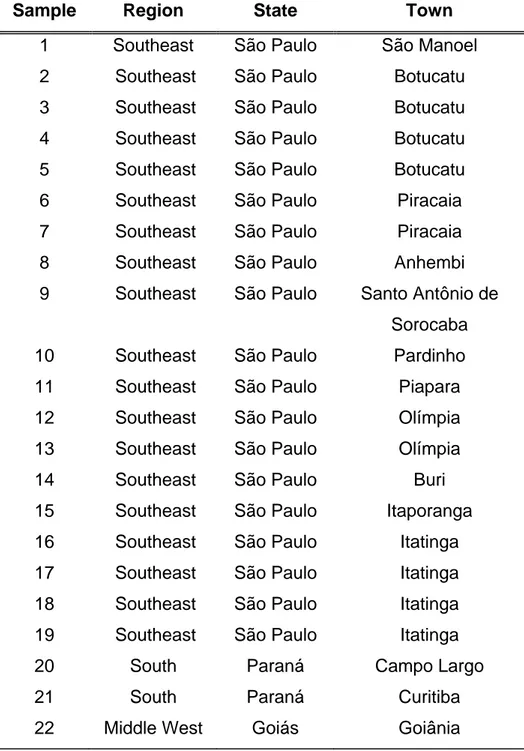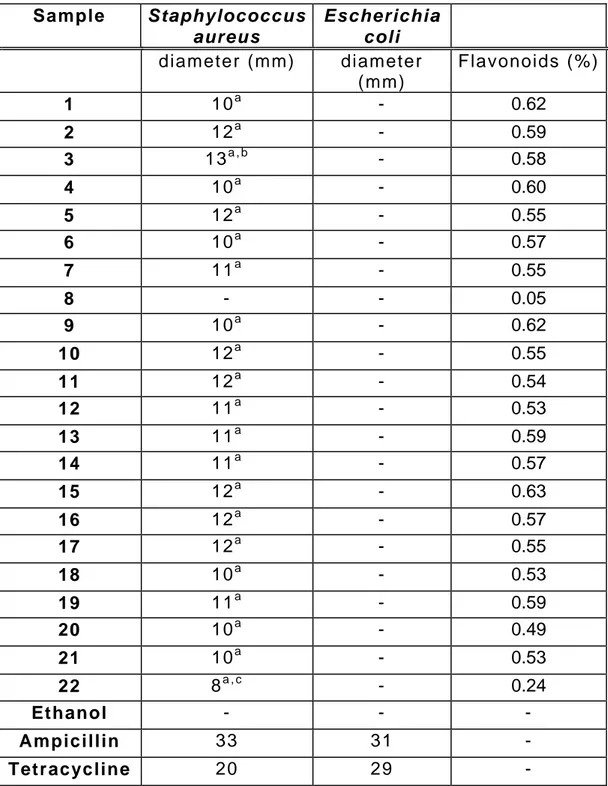ANTIBACTERIAL ACTIVITY OF PROPOLIS COLLECTED IN DIFFERENT REGIONS OF BRAZIL
GONSALES G. Z. (1), ORSI R. O. (1), FERNANDES JÚNIOR A. (2), RODRIGUES P. (1), FUNARI S. R. C. (1)
(1) Department of Production and Animal Exploration, School of Veterinary Medicine and Animal Husbandry, São Paulo State University, UNESP, Botucatu, São Paulo State, Brazil; (2) Department of Microbiology and Immunology, Biosciences Institute, UNESP, Botucatu, São Paulo State, Brazil.
ABSTRACT: The aim of this study was to investigate the antibacterial activity of
propolis samples from Goiás, Paraná and São Paulo States, Brazil, and their
flavonoids content. Ethanolic extracts of propolis (EEP) were prepared (30g of
propolis in 70% ethanol), and the microorganisms Staphylococcus aureus and
Escherichia coli were tested. The methodology employed was agar diffusion using
filter paper discs. Ampicillin and tetracycline were used as controls. Antibacterial
activity was determined by the reading of inhibition zone diameters (mm) after 24
hours incubation at 37°C. Results demonstrated that EEP inhibited the growth of
Staphylococcus aureus but not that of Escherichia coli. Tetracycline and ampicillin
showed an efficient action against both bacteria. Flavonoids content was variable,
depending on the propolis sample. According to the results, it may be concluded that
EEP showed effective action against Gram-positive bacteria, independently on their
geographic origin, and a positive correlation between antibacterial activity and
flavonoids content.
KEY WORDS: propolis, antibacterial activity, flavonoids.
CORRESPONDENCE TO:
INTRODUCTION
Propolis has been used in folk medicine since ancient times. Recently, it has been
the subject of several studies aimed at elucidating its biological properties, such as
antibacterial, antiviral, anti-inflammatory, anticarcinogenic, immunomodulatory,
among others (1, 3, 5, 14, 15, 16, 17, 21).
Propolis antibacterial activity has been widely investigated, showing a major effect on
Gram-positive and a limited action on Gram-negative bacteria (6, 7, 9, 17, 19, 21,
22).
However, its biological properties may vary according to different plant sources (2). In
Brazil, there are many plants that bees could visit as sources of propolis, and
depending on the geographic location, its chemical composition may differ.
Based on these observations, the aim of this work was to investigate the antibacterial
activity of ethanolic extracts of propolis (EEP) produced in different regions of Brazil
against Staphylococcus aureus and Escherichia coli and to determinate the
flavonoids content of propolis samples.
MATERIAL AND METHODS Propolis samples
Propolis (twenty-two samples) was collected by Apis mellifera in different regions of
Brazil: Goiás, São Paulo and Paraná States (Table 1). Propolis samples were ground
and extracted (30g of propolis, completing the volume to 100ml with 70% ethanol) in
absence of bright light, at room temperature, and after a week, extracts were filtered
(15).
Flavonoids Content
Methanolic solutions of quercetin in the range of 4.0-12.0µg/ml were used as
reference. Ethanolic extract of propolis (0.4ml), methanol (20ml), and 5% AlCl3
(0.5ml) were added and the volume completed to 50ml with methanol at 20ºC. After
30 min, absorbances were measured at 425nm (23).
Microorganisms
Staphylococcus aureus ATCC 25923 and Escherichia coli ATCC 35218 strains were
Microbiological tests
Agar disc diffusion method was employed for the determination of antimicrobial
activities of EEP (13). Suspensions of tested microorganisms (0.5 Mac Farland scale)
were spread into solid media plates. Filter paper discs (6mm in diameter) were
impregnated with 20µl of each EEP sample and with ethanol (control) and the
inoculated plates were incubated at 37ºC for 24 hours. Diameters of the inhibition
zones were measured in millimeters. All the tests were performed in triplicate.
Statistical Analysis
Results were analyzed using Analysis of variance. The probability of 0.05 was
chosen as the significant level (24). Pearson correlation was used in order to verify a
possible correlation between EEP and flavonoids content.
RESULTS AND DISCUSSION
Flavonoids content (%) varied from 0.05 (sample 8 – Anhembi, São Paulo State) to
0.63 (sample 15 – Itaporanga, São Paulo State) (Table 2). They also varied
according to the geographic region.
Massuda (12) mentioned 0.53%-1.49% range of flavonoids from propolis, and Sato
(20) obtained from 0.0% to 7.04%. Marcucci et al. (2, 11) verified low flavonoids
content in Brazilian propolis samples (0.84%). Gonzales & Bernal (8) suggested that
tropic propolis is poor in flavonoids. On the other hand, Kujumgiev et al. (10) showed
elevated values of flavonoids in Bulgarian propolis (42%).
With regard to propolis antibacterial activity, EEP inhibited Staphylococcus aureus
growth, with inhibition diameters from 8 (sample 22 – Goiânia, Goiás State) to 13mm
(sample 3 – Botucatu, São Paulo State). Sample 3 was statistically different from
sample 22 (p<0.05). Tetracycline and ampicillin showed an antibacterial activity with
inhibition diameters of 23 and 33 mm, respectively (Table 2).
Park et al. (18) observed propolis action against Staphylococcus aureus, using the
agar diffusion methodology. Derevice & Ozino (4), Fernandes Jr. et al. (7), Kujumgiev
et al. (10), Sforcin et al. (21), and Marcucci et al. (11) verified susceptibility of
Staphylococcus aureus to propolis.
Massuda (12) verified that propolis inhibited Staphylococcus aureus growth (10 to
11mm, suggesting variability in the biological activity of EEP. Differences in propolis
biological activity may be related to its botanical origin, reflecting differences in its
chemical composition.
With regard to Escherichia coli, EEP did not show any antibacterial activity.
Tetracycline and ampicillin showed antibacterial activity, with inhibition diameters of
31 and 29mm, respectively (Table 2).
Sato (20) verified moderate antibacterial action of EEP against Escherichia coli
(inhibition diameters from 8.0 to 8.8 mm), and Orsi et al. (17) demonstrated an
elevated minimal inhibitory concentration of propolis against Salmonella sp,
concluding that propolis shows limited action on Gram-negative bacteria. In this work,
EEP was effective only against Gram-positive bacteria.
As a control of propolis solvent, 70% ethanol did not show antibacterial activity on the
studied strains (Table 2). These results suggest that antibacterial action of EEP
against Staphylococcus aureus was due to propolis constituents.
A positive correlation (p<0.01) between the flavonoids content and the antibacterial
activity of EEP against Staphylococcus aureus was observed (Table 2). Flavonoids
are reported to be the most important group of compounds with propolis biological
activity (2).
We can conclude from this work that EEP have antibacterial activity mainly on
Table 1: Propolis samples.
Sample Region State Town
1 Southeast São Paulo São Manoel
2 Southeast São Paulo Botucatu
3 Southeast São Paulo Botucatu
4 Southeast São Paulo Botucatu
5 Southeast São Paulo Botucatu
6 Southeast São Paulo Piracaia
7 Southeast São Paulo Piracaia
8 Southeast São Paulo Anhembi
9 Southeast São Paulo Santo Antônio de
Sorocaba
10 Southeast São Paulo Pardinho
11 Southeast São Paulo Piapara
12 Southeast São Paulo Olímpia
13 Southeast São Paulo Olímpia
14 Southeast São Paulo Buri
15 Southeast São Paulo Itaporanga
16 Southeast São Paulo Itatinga
17 Southeast São Paulo Itatinga
18 Southeast São Paulo Itatinga
19 Southeast São Paulo Itatinga
20 South Paraná Campo Largo
21 South Paraná Curitiba
Table 2: Antibacterial activity of Ethanolic Extracts of Propolis (EEP), 70% ethanol,
tetracycline and ampicillin (inhibition zone diameters, mm) against Staphylococcus
aureus and Escherichia coli and flavonoids content (%) of each EEP.
Sample Staphylococcus aureus
Escherichia coli
diameter (mm) diameter
(mm)
Flavonoids (%)
1 10a - 0.62
2 12a - 0.59
3 13a , b - 0.58
4 10a - 0.60
5 12a - 0.55
6 10a - 0.57
7 11a - 0.55
8 - - 0.05
9 10a - 0.62
10 12a - 0.55
11 12a - 0.54
12 11a - 0.53
13 11a - 0.59
14 11a - 0.57
15 12a - 0.63
16 12a - 0.57
17 12a - 0.55
18 10a - 0.53
19 11a - 0.59
20 10a - 0.49
21 10a - 0.53
22 8a , c - 0.24
Ethanol - - -
Ampicillin 33 31 -
Tetracycline 20 29 -
REFERENCES
1 AMOROS M., SAUVAGER F., GIRRE L. In vitro antiviral activity of propolis.
Apidologie, 1992, 23, 231-3.
2 BANKOVA V., MARCUCCI MC., CASTRO SL. Propolis: recent advances in
chemistry and plant origin. Apidologie, 2000, 31, 3-15.
3 CASTRO SL. Propolis: biological and pharmacological activities. Therapeutic uses
of this bee-product. Annu. Rev. Biol. Sci., 2001, 3, 49-83.
4 DEREVICE A., OZINO OI. Azione della propoli su microrganismi dell’ambiente
ospedaliero. Ann. Microbiol. Enzimol., 1991, 41, 231-2.
5 DOBROWOLSKI JW., VOHORA SB., SHARMA K., SHAH SA. Antibacterial,
antifungal, antiamoebic, anti-inflammatory and antipyretic studies on propolis
bee products. J. Ethnopharmacol., 1991, 35, 77-82.
6 FERNANDES Jr. A., LOPES CAM., SFORCIN JM., NAQVI SA., DDIYA PC.,
FUNARI SRC. Population analysis of susceptibility of propolis in reference
strains of Staphylococcus aureus and Escherichia coli. J. Venom. Anim.
Toxins, 1997, 3, 287-94.
7 FERNANDES Jr. A., SUGIZAKI MF., FOGO ML., FUNARI SRC., LOPES CAM. In
vitro activity of propolis against bacterial and yeast pathogens isolated from
human infections. J. Venom. Anim. Toxins, 1995, 1, 63-9.
8 GONZALES A., BERNAL R. Propóleos: un camino hacia la salud. La Habana:
Pablo de la Torriente, 1997. 132p.
9 GRANGE JM., DAVEY RW. Antibacterial properties of propolis (bee glue). J. R.
Soc. Med., 1990, 83, 159-60.
10 KUJUMGIEV A., TSVETKOVA I., SERKEDJIEVA Y., BANKOVA V., CHRISTOV
R., POPOV S. Antibacterial, antifungal and antiviral activity of propolis of
different geographic origin. J. Enthonopharmacol., 1999, 64, 235-40.
11 MARCUCCI MC., FERRERES F., GARCIA-VIGUERA C., BANKOVA VS., DE
CASTRO SL., DANTAS AP., VALENTE PH., PAULINO N. Phenolic
compounds from Brazilian propolis with pharmacological activities. J.
Ethnopharmacol., 2001, 74, 105-12.
12 MASSUDA KF. Parâmetros físico-químicos e atividade biológica da própolis
submetida a diferentes tipos de extração. Rio Claro: Universidade Estadual
13 NATIONAL COMMITTEE FOR CLINICAL LABORATORY STANDARDS.
Performance standards for antimicrobial disk susceptibility tests.
Pennsylvania: NCCLS, 2002. (M100-S12).
14 ORSI RO., FUNARI SRC., SOARES AMVC., CALVI SA., OLIVEIRA SL.,
SFORCIN JM., BANKOVA V. Immunomodulatory action of propolis on
macrophage activation. J. Venom. Anim. Toxins, 2000, 6, 205-19.
15 ORSI RO., SFORCIN JM., FUNARI SRC., BANKOVA V. Effects of propolis from
Brazil and Bulgaria on bactericidal activity of macrophages against
Salmonella typhimurium. Int. Immunopharmacol., 2005, 5, 359-68.
16 ORSI RO., SFORCIN JM., FUNARI SRC., GOMES JC. Effect of propolis extract
on the guinea pig lung mast cell. J. Venom. Anim. Toxins incl. Trop. Dis.,
2005, 11, 76-83.
17 ORSI RO., SFORCIN JM., RALL VLM., FUNARI SRC., BARBOSA L.,
FERNANDES Jr. A. Susceptibility profile of Salmonella against the
antibacterial activity of propolis produced in two regions of Brazil. J. Venom.
Anim. Toxins incl. Trop. Dis., 2005, 11, 109-16.
18 PARK YK, IKEGAKI M., ALENCAR SM. Classificação das própolis brasileiras a
partir de suas características físico-químicas e propriedades biológicas.
Mensagem doce, 2000, 58, 2-7.
19 PARK YK., KOO MH., IKEGAKI M., CURY JA., ROSALEN PL. Effect of propolis
on Streptococcus mutans, Actinomyces naeslundii and Staphylococcus
aureus. Rev. Microbiol., 1998, 29, 143-8.
20 SATO PM. Inter-relações das características físicas, químicas e biológicas de
própolis das regiões sul e sudeste do Brasil. Rio Claro: Universidade
Estadual Paulista, Instituto de Biociências, 2002. 33f. [End of Course Paper]
21 SFORCIN JM., FERNANDES Jr. A., LOPES CAM., BANKOVA V., FUNARI SRC.
Seasonal effect on Brazilian propolis antibacterial activity. J.
Ethonopharmacol., 2000, 73, 243-9.
22 WOISKY RG., GIESBRETCH A., SALATINO A. Antibacterial activity of a
formulation prepared with propolis from Apis mellifera L. In:
IBEROLATINOAMERICAN MEETING APIC, 4, Córdoba, 1994.
23 WOISKY RG., SALATINO A. Analysis of propolis: some parameters and
procedures for chemical quality control. J. Apic. Res., 1998, 37, 99-105.

